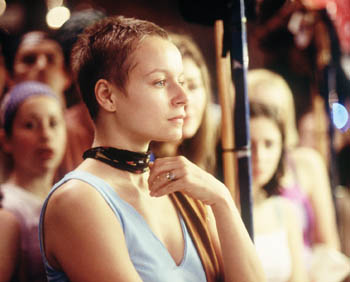![[Metroactive Movies]](http://metroactive.com/movies/gifs/movies468.gif)
[ Movies Index | Show Times | Silicon Valley | Metroactive Home | Archives ]
My Wrong Foot
Jim Sheridan's 'In America' paints a soft-focus view of an immigrant family's life in New York
By Richard von Busack
EVERY GOOD filmmaker gets something different out of New York city, using the idea of the city to express their longings and hatreds. If there's anything's distinctive in the film In America, it's director Jim Sheridan's peculiarly audience-pleasing view of New York as a city of healing.
Sheridan (My Left Foot) wove the film out of his own family's memories. The screenplay is credited to the director and his two daughters, Naomi and Kirsten. Realistic anecdotes of family life stick out of the more magical-realist tale-spinning. Note how quickly an immigrant child learns to say "cool," all offhand, just as an American girl would. Observe the sharply handled scene where, in the grip of night terrors, a little girl named Ariel (Emma Bolger) isn't sure her father is who he says he is.
But one line you'll be hearing on the Oscar show, whether you want to or not, is Christy (Sarah Bolger), the narrator, turning on her troubled parents: "I've been carrying this family on my back for a year." What family is so saintly that it wouldn't laugh in a kid's face when it heard that? The answer: a family in a Hollywood movie.
Some have imagined In America as a nostalgia piece; the evidence comes in the film's quotations from E.T., its tiptoe attitude about AIDS and Samantha Morton's Sinead O'Connor cropped hairstyle (most likely a souvenir of her bald-headed role in Minority Report). Unless that billboard of Ocean's 11 was up there in Times Square in 1982, In America seems to take place a couple of years ago, during the brief theatrical rerelease of E.T.
A family of Irish émigrés drives to New York from Canada in a station wagon with mismatched tires. Their arrival in Manhattan is a real highlight, with a babble of radio voices filling the car as they cross over to Manhattan via tunnel. Christy says, "I heard New York before I saw it."
The sights of the town are seen through Christy's video camera. Dad Johnny (Stephen Rea look-alike Paddy Considine) soon finds them a place to live. It's a black-painted one-room walkup flat in Hell's Kitchen. The building houses a nest of junkies, and a howling man lives behind one of the doors downstairs. The family languishes during a humid summer of boiling heat interspersed with ferocious thunderstorms.
The family's emotional weather isn't any calmer. They've come to New York to escape the memory of the death of one of their own, as well as to further Johnny's career as an actor. His grief is hazarding his career: "I can't feel." Johnny needs a fresh crisis in order to grieve for his lost son, and the pregnancy of his wife, Sarah (Morton), provides it.
This isn't one of Morton's most distinctive roles. She's particularly passive in the scene where she encourages her husband to throw the family's money away, playing ringtoss at a carnival to get his daughter an E.T. doll. As always, Morton has moments--a mad lovemaking scene and an instance where she swoops down on her daughter like a panther.
The Bolger sisters are natural actresses. They shine in a sequence derived from the famous Halloween sequence from Meet Me in St. Louis. It's the moment when the howling man downstairs is confronted. The madman, an abstract artist named Mateo, turns out to be the splendidly physiqued Djimon Hounsou. Mateo's howling isn't wrath but sorrow. Eventually, in a turn of almost Dickensian quaintness, Mateo becomes a mascot. Since Hounsou's supernaturally good-looking, he keeps getting cast as a harmless extraterrestrial: Mateo says he identifies with Spielberg's bug-eyed alien, that he wants to go home. Remember that the slave he plays in Amistad also wants to go home, tracing the path from here to there with his finger.
In the fall, the two girls start Catholic school. At a school pageant, Christy sings a note-for-note cover of Sheila Behman's memorable version of "Desperado," as backed up by the Langley School Project. This song--just like the Byrds' "Turn, Turn, Turn" and the Lovin' Spoonful's "Do You Believe in Magic?"--works its relentless nostalgic magic.
Again, Sheridan gives us patches of realistic urban rottenness: a robbery where the junkie robber apologizes for having to do it; a newsstand owner who refuses to give a nickel's credit to a regular customer. But the scenes inside the big black flat were filmed in a studio in Ireland, and they don't have the funk of New York. The exteriors don't match the interiors.
The rapturous critical response to In America must have something to do with every moviegoer's soft spot for New York. We all want to believe that the gateway to America is a city that welcomes all and that the eccentric locals will--after some hazing at first--turn out to be benefactors. A thick streak of schmaltz runs through In America, and the streak gets thicker as the movie runs on. Because of the poised acting and the independent-movie techniques, the critics have been letting Sheridan get away with it.
[ Silicon Valley | Metroactive Home | Archives ]
Copyright © Metro Publishing Inc. Metroactive is affiliated with the Boulevards Network.
For more information about the San Jose/Silicon Valley area, visit sanjose.com.
![]()

Tasting the Big Apple: Samantha Morton plays a troubled mother looking for emotional stability 'In America.'
In America (PG-13; 103 min.), directed by Jim Sheridan, written by Jim, Naomi and Kirsten Sheridan, photographed by Declan Quinn and starring Samantha Morton and Paddy Considine, opens Friday at selected theaters.
Send a letter to the editor about this story to letters@metronews.com.
From the December 11-17, 2003 issue of Metro, Silicon Valley's Weekly Newspaper.